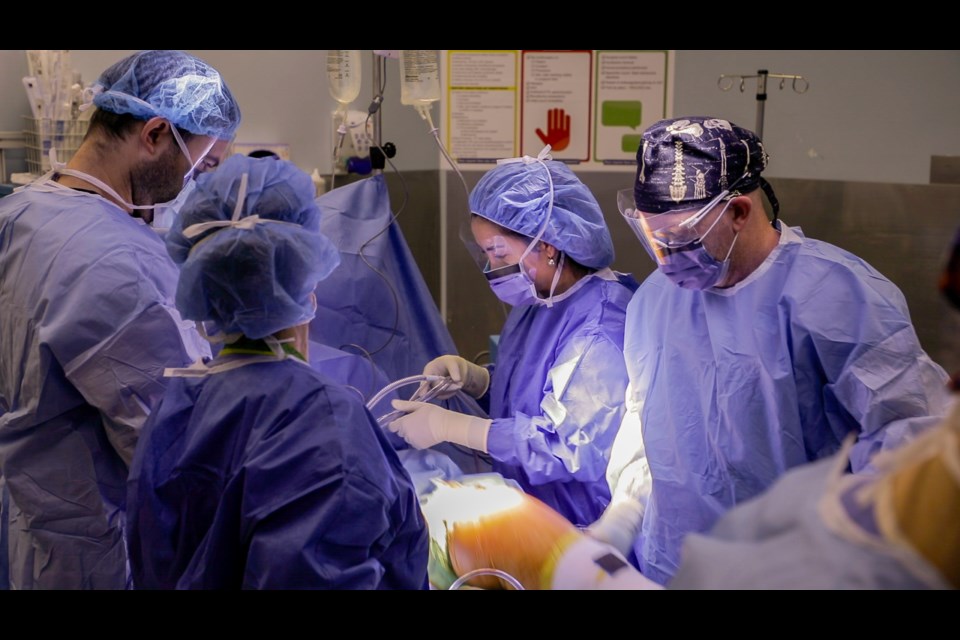This is the second of a series of articles exploring the challenges and impact of overcrowding in various departments at Southlake Regional Health Centre in Newmarket, one of Ontario's most overloaded hospitals.
Sixty-year-old Lorrie Locke has been to Southlake Regional Health Centre several times over the years — most recently in 2020 to have anterior hip replacement surgery that was delayed six months during the COVID-19 pandemic.
She was gearing up for the worst because of the pandemic, but "it was business as usual," the patient said, adding she was pleasantly surprised at how efficient everything was.
After her surgery, Locke spent the night in an overflow area that she said was fairly spacious and private. Pre-COVID-19, she recalls the hospital being far busier.
Southlake is doing a good job trying to meet the demand of the growing population and the needs of its patients have not been sacrificed, she said.
"Everyone is getting service they need. It was very reassuring while I was there, everyone was doing their job," she said. "They weren't cutting in corners."
Southlake's 15 operating rooms "look nothing the way a current one would," according to Dr. Sara Temple, chief of surgery, and although the dated rooms are less than ideal, it hasn't affected the hospital's ability to provide proper patient care, she said.
"We still make do and we do all of the things that we should be doing."
Of the 14 usable ORs — one is so small that it's used for storage rather than surgery — nine range in sizes from 400 to 600 square feet, which is inadequate to house the modern equipment used for surgeries today.
Many surgical procedures are minimally invasive, also known as endoscopic surgery, in which a camera is inserted through a small incision. The procedures are performed in the dark and require the use of several large monitors displayed around the room.
When the rooms were designed in 1973, minimally invasive surgery didn't exist and no one could have predicted the space required for all the extra equipment and people required to perform surgeries, Temple said.
When the smaller ORs are filled with a patient, anesthetist, respiratory therapist, at least two surgeons — sometimes three — at least two nurses— sometimes three — several nursing tables and a lot of equipment they "start to get pretty tight," said Temple.
Tight quarters can become a hazard in a dark space. During one procedure, a senior nurse tripped over cords and hurt herself, Temple said.
Modern ORs are not only bigger but much of the heavy equipment is mounted on the ceiling, enabling doctors and nurses to move around freely and safely. In the hospital's smaller ORs, equipment is mounted on stands.
According to Temple, the ideal standard size for an OR today is between 1,000 and 1,500 square feet.
The rooms also lack storage space, so a lot of the equipment that should be close at hand is stored elsewhere, she added.
"We wind up using our hallway — which is not ideal obviously — as storage."
Southlake's less than modern ORs and lack of space haven't hindered its ability to retain top-notch physicians who perform modern procedures.
Locke's hip replacement procedure — a minimally invasive surgical technique — is relatively new in Canada and something for which Southlake's orthopedic surgeon, Dr. Patrick Gamble, is known.
According to the American Association of Hip and Knee Surgeons, the anterior approach is only used in 15 to 20 per cent of hip replacement surgeries.
"I highly recommend Dr. Gamble, oh my goodness, he really is groundbreaking," said Locke.
Patients like Locke are discharged the day of their procedure or after a single night stay. whereas those who have undergone traditional hip replacements typically stay four to five days in hospital.
In a You Tube video, Gamble called the level and quality of service "a testament to Southlake as a hospital and to our department of surgery."
"Our orthopedic department is phenomenal and they're really pioneering a lot of amazing surgeries," said Temple.
Southlake's ORs were built to handle approximately 6,000 cases a year and they now handle 12,000 cases with the same facilities which, said Temple, which requires a lot more efficiency.
"We're doing a lot of amazing things despite those limitations," she said.
"One of the really special things about this place," said Temple, is that that even though Southlake provides leading edge care "it still maintains a real community hospital feel."



